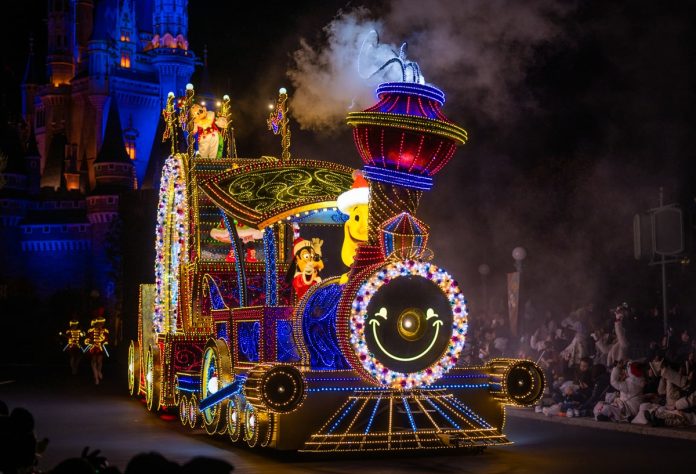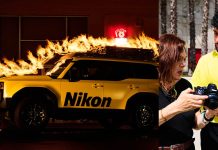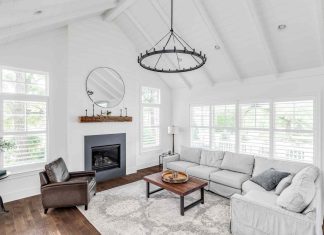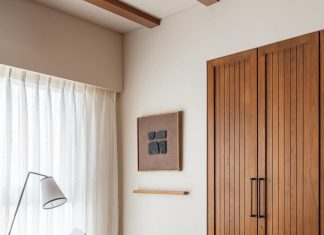

I can’t remember the last time there was a game-changing piece of gear for photography at Walt Disney World, Disneyland, and the other parks. The Nikon D600, Sigma 35mm f/1.4, Sony RX100, or one of the innovative ultra-wides. All of those cameras and lenses are over a decade old, so it’s been a while.
For the overwhelming majority of you, the game-changer is probably the device you’re using to read this–one of the iPhones or Androids, or whichever phone you use. These devices have really bridged the gap and made most point & shoot cameras obsolete. They’re currently working on killing enthusiast-level DSLRs and mirrorless cameras. That powerful little computer in my pocket is often the only camera I’m carrying.
Photography has been democratized to such a degree that it’s rare for me to post about gear. Usually just once per year in my annual ‘What’s in My Camera Bag’ post, and even that garners little interest as compared to a decade ago. It’s actually been so long that the overwhelming majority of you are probably no longer here for the photos…or even know that I am a photographer. I’d be lying if I said inquiries about my camera bag were still common–they probably don’t crack the top 100 of questions we’re asked by readers.
Nevertheless, I do still put a lot of time and effort into photography. Well, at least the “taking photos” part of things. For me, there’s tremendous enjoyment in the ritual of photography itself. I love getting up before sunrise, running around at sunset chasing that fleeting light, or staying until the bitter end of the night in Magic Kingdom as the park clears out. I don’t particularly know why, but I find peace in the photography process, and more connected to the world around me. I feel most alive at these times, even when I’m dead tired.
I cannot say the same about editing photos–I already spend too much sitting at the computer. I still have tens of thousands of photos sitting on hard drives, completely untouched, from last year. The only ones I’ve managed to get processed consistently are those of Megatron, who has also been the catalyst for massive changes to my photography style.
Nevertheless, last September (14 months ago, not 2 months ago) I discovered a new-to-me lens that I could not resist sharing, as it’s been a massive game-changer and bag-lightener for my photography at Walt Disney World, Disneyland and while traveling internationally…


My new favorite lens for Disney or travel photography is the Tamron 35-150mm f/2-2.8 for Nikon. (There’s also a model for Sony that’s inexplicably less expensive.)
Even though I know this review won’t garner 5% of the interest as a menu update at Tony’s Town Square, I just felt compelled to share. In part because, unlike Tony’s Town Square, I love this lens. Also in part because the Tamron 35-150mm f/2-2.8 is on sale for 15% off. (It’s even less expensive for Sony, but that discount is somehow more normal–it’s just cheaper for that mount.)
It’s still far from an inexpensive lens, but given what it compares to and potentially replaces in your camera bag, this lens offers tremendous bang-for-buck. But if for some reason this is still too expensive, you might consider the Rokinon 35-150mm f/2-2.8. That lens is either the biggest coincidence ever, or it’s a reverse-engineered knock-off of this one. (Note: I have not used the Rokinon, so this is not a product endorsement–just pointing out something suspiciously similar and cheaper.)
As always, we earn commission on your purchases from Amazon, but that doesn’t impact product recommendations. This gem of a lens is being recommended because it’s an amazing purchase even at full price, and a good deal at $1,700.


Why this lens is a potential game-changer might be obvious to photographers just in its name. The 35-150mm zoom range coupled with a variable aperture of f/2-2.8. Those are numbers that normally don’t go together, so I was immediately incredulous about this lens. Would it be yet another jack of all trades, master of none third party lens?
The reason I found the Tamron 35-150mm f/2-2.8 in the first place is because I was looking for an alternative to my Nikon 70-200mm f/2.8. A lens I love but, if I’m being honest, that I’ve “outgrown.” You cannot carry both diapers and that lens–it just isn’t possible. (Sorry, I don’t make the rules.)
Even the diaper-less among you might have similar misgivings about the 70-200mm f/2.8 lens. It’s heavy, large, and 70mm often too long for many situations. Consequently, you also need to pair that with a 24-70mm lens or 35mm prime and possibly a second camera.
This might sound like overkill for most Disney photography enthusiasts, but one specific scenario where it comes up often is parade photos. I had frequently carried two cameras with that setup for Festival of Fantasy, Boo to You, Mickey’s Once Upon a Christmastime Parade, etc.


My goal with the Tamron 35-150mm f/2-2.8 was to replace my Nikon 70-200mm f/2.8.
I ended up replacing that lens, as well as my 35mm f/1.4, 50mm f/1.8, and 85mm f/1.8. In fairness, it’s not a complete or perfect replacement for all of those lenses–nor was I carrying all 4 every single time we went to the parks. But I did frequently pack them all in my bag “just in case” before trips, with 2-3 of them sitting in the hotel. Most of the time, especially post-baby, I opted for the Nikon 14-30mm, Nikon 28-300mm and either the 35 or 50mm prime and called that “good enough.” (That super-zoom was not good enough.)
Now, the Tamron 35-150mm f/2-2.8 is on my camera the vast majority of the time. For over the last year, it’s been one of only two lenses I’ve carried, along with the Nikon 14-30mm f/4. For me, these two lenses are the perfect companions, an ultra-wide for landscapes where faster apertures aren’t necessary plus a workhorse zoom that covers almost everything else.


It should go without saying given the price, but the Tamron 35-150mm is not for everyone. This lens is sizable, and heavier than it looks. (The photo above was not shot with the Tamron, but to show it slung to my side.)
Personally, I don’t view this as a real negative. It’s lighter and smaller than the 70-200mm f/2.8 alone, and noticeably so. While I want less weight, I’m not expecting miracles–due to the laws of physics or whatever, every size or weight decrease is a compromise.
What I love about the Tamron 35-150mm is its professional build quality, heft, and balance. To the touch, it reminds me of a Sigma Art lens, which is very much high praise. Thankfully, it doesn’t feel plasticy or like a toy lens, and I’ll happily take the extra weight for a tougher and more durable lens–especially as someone who travels and punishes my gear. It’s rugged and fully weather-sealed, and I’ve already put the Tamron through its paces shooting in a variety of conditions.
With that said, I have to acknowledge that the biggest complaint that I’ve seen about the Tamron 35-150mm is its weight (2.6 pounds or 1,165 g). Many say this is too heavy for travel, but again, it’s much lighter than the 70-200 alone, and certainly lighter than the 2-3 lenses it replaces. It significantly lightened my camera bag and, frankly, I struggle to see the reasonable comparison that makes this the heavier option. To each their own, though.


As mentioned above, the Tamron starts at f/2 at 35mm, rivaling my primes through 50mm. At the long end, it’s still a fantastic f/2.8. The drop-down occurs gradually, not hitting f/2.8 until 135mm. This offers plenty of room to work in tougher lighting conditions and play with the depth of field in creative ways, while allowing for faster shutter speeds or lower ISOs.
The most demanding condition in which I shoot is dark rides, and the Tamron performed admirably in those. It’s the first time I’ve ever been able to shoot wide scenes and tightly-framed Audio Animatronics on the same ride-through. This is especially useful when it comes to popular attractions that you’ll only do once.
The Tamron 35-150mm was also wonderful on Mystic Manor, Sindbad’s Storybook Voyage, Frozen Ever After (both versions), Haunted Mansion Holiday, and even show scenes on Big Grizzly Runaway Mountain Runaway Mine Cars (a roller coaster). I wish I would’ve had this lens back when Fantasy Springs opened. The Tamron 35-150mm f/2-2.8 is, without question, the best single dark ride lens on the market.


My only minor quibble was that sometimes the autofocus was slow to keep up on dark rides when quickly zooming from the wide end of the range to the long end. In fairness, this is at least partially a byproduct of the demanding circumstances. It’s dark, I’m moving, and zooming quickly. The average wedding or travel photographer isn’t going to be doing these things.
In non-dark ride scenarios, the autofocus was perfect. It uses Tamron’s VXD or “Voice-coil eXtreme-torque Drive,” which is the company’s proprietary ultrasonic drive. You know if something has a fancy name, it must be good. And it is.
Focusing is fast and snappy during most use cases, but still a half-step behind the pro-grade Nikons. The focus motor is quiet–I’d even call it silent, but again, I’m not a wedding photographer shooting in churches.


One of my pre-purchase fears about the Tamron 35-150mm was that its image quality would be noticeably worse than the lenses it’d be replacing. I was shocked that, for the most part, it performed on par with all of them. Maybe a half-step behind the Sigma 35mm f/1.4 and Nikon 70-200mm at the long end, but barely noticeable. Those are also top-tier lenses–the sharpest in my bag.
Wide open, the Tamron is extremely sharp at 35mm, and still very sharp until around 135mm. Zoomed all the way, I found it to be good. But again, all of this is wide open. Stop it down to f/4 or so and it’s near-perfect. If you’re shooting at f/8, it’s going to be impossible to distinguish this from the pro-grade Nikons or even the Sigma Arts.
As a “real world” photographer who is shooting actual subjects–not lab charts–I found the sharpness and image quality of the Tamron to be near-perfect, especially considering the apertures. There is some vignetting and edge softness, but I’m adding artificial vignettes to 95% of photos in post, so I couldn’t care less about this.


Bokeh is highly subjective, but I found the out-of-focus area the Tamron produces to be good enough. It’s not beautiful and buttery like the Sigma 35mm (a lens I’ve kept in my bag through thick and thin since it was first released because nothing has ever topped it for me), but it’s almost equivalent to the Nikon 70-200.
The bokeh is smooth and pleasing to the eye, for the most part. The one potential exception is that it can take on an onion-ring quality if the background (or foreground) has bright points of light. Since a lot of my photography in the last few months has revolved around the holiday season, I noticed this on occasion when shooting Christmas lights.
This is not something that bothers me, and I don’t even really think it’s all that noticeable in these photos. But I know some photographers are very particular about this. Still miles better than my Nikon 28-300mm and any other all-in-one lenses I’ve previously used, and by a wide margin.


I’ve also seen complaints about flare, but I love that and the sunbursts the Tamron produces. This is another subjective thing, and honestly, I only want a lens to control flare so much. I love to purposefully introduce flare in photos, and think this is an underrated creative application of lenses.
I feel likewise about shallow depth of field in landscape photos to provide interesting depth. Ditto the warm glow that shooting at f/2 with the sun slightly out of frame can provide. The Tamron is a lens with personality, which is a huge check in the strengths column for me. Character is sometimes missing from the pro-grade Nikons, which strive for technical perfection above all else.
But again, I’m a “real world” photographer and not someone who reviews lenses by taking pictures of charts in a lab. If that’s your preferred use case, this review was probably a waste of your time.


Ultimately, the Tamron 35-150mm f/2-2.8 is easily my favorite do-it-all lens for Disney photography. This review only scratches the surface of its potential use-cases. Want a wide photo of your whole food spread but also a cupcake close-up? The Tamron’s got you covered. Handheld night landscapes? This does the trick. Photos shot amongst a crowd? The shallow depth of field blurs faces with ease.
Perhaps the best endorsement of this lens is how much I’ve used it. Since purchasing the Tamron, it and the Nikon 14-30mm have been the only lenses in my bag the vast majority of time. During the last ~14 months, I’ve used the Tamron for over 75% of shots–for a total of over 30,000 photos.
That may not seem significant, but prior to this, the Nikon 14-30mm was my most-used lens, accounting for (conservatively) over 60% of my photos. The next highest lens was the Nikon 24-200mm, which barely cracked 20%. None of the primes or 70-200mm broke the 10% barrier, largely due to weight or inconvenience.
Again, things have changed now that we now have a daughter, but I’m guessing many of you also have kids–or don’t want to lug around a half-dozen lenses for other reasons. Even when I’ve gone on my own to Mickey’s Not So Scary Halloween Party, I’ve used this a lot. Likewise, there have been hot summer days when I’ve gone without a camera bag at all and just carried this lens. Now that was a real game-changer in the Florida heat and humidity!


It’s to the point that there have been a couple of entire days when the Tamron 35-150mm didn’t leave my camera. That’s something that would’ve been unheard of in the past, as I couldn’t fathom not using my ultra-wide. I’ve been beyond satisfied with this lens, and it has reinvigorated my photography, enabling me to take creative photos, everyday ones, and more.
The Tamron is also already proving fantastic for a very mobile toddler, which is my favorite use for it of all. Seriously, that’s probably the most challenging type of photography I do now, and the zoom range plus with the snappy autofocus and aperture means I’m not missing those priceless shots. For that reason alone, the Tamron 35-150mm f/2-2.8 is well worth it, even at full price. It’s not perfect, but I’m honestly shocked at just how few compromises it makes.
Here are more photos I’ve shot with the Tamron 35-150mm f/2-2.8 if you need more convincing:




































































































































That’s far from an exhaustive roundup of photos. Anything new from the last year-plus that’s not an ultra wide angle was captured with the Tamron 35-150mm. There hasn’t been a single day when I’ve carried any other telephoto or all-in-one lens (meaning most of my photos of Starlight, Epic Universe, etc. have been with this lens).
The Tamron 35-150mm f/2-2.8 is not perfect, but I’m honestly shocked at just how few compromises it makes. It earns my highest recommendation after over one year of nonstop usage in a variety of circumstances.
If you want more in-depth reviews of a broader selection of equipment, the best place to start is Tom’s Ultimate Disney Parks Photography Guide, which covers a variety of topics from links to tutorials, tips, and tricks to recommendations for point & shoots, DSLRs, lenses, and more. (Many of these are pretty old and haven’t been updated in a while, but the underlying ideas and principles still apply.)
Your Thoughts
Have you shot with the Tamron 35-150mm? What do you think of this lens? Appealing to you, or is the idea of an all-in-one uninteresting to you? What’s in your camera bag? Any questions? Hearing feedback from other photographers is both interesting to us and helpful to other readers, so please share your thoughts below in the comments!













